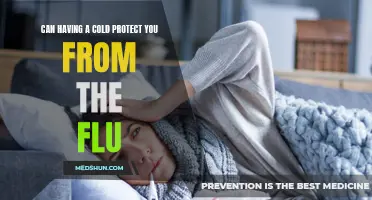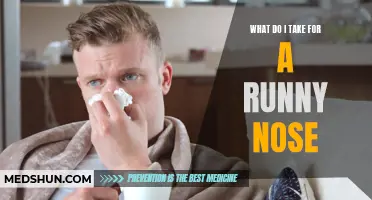
Have you ever wondered how a tiny sneeze or cough can lead to a full-blown cold? It seems that catching a common cold is as easy as catching a basketball thrown at you. But how exactly do these pesky viruses manage to invade our bodies and wreak havoc? In this article, we will delve into the fascinating world of cold-causing viruses and explore the different ways they can be caught. So grab a tissue and brace yourself for a journey into the microscopic realm of the common cold.
| Characteristics | Values |
|---|---|
| Colds are caused by | viruses |
| Method of transmission | respiratory droplets |
| Common symptoms | runny nose, sore throat, sneezing |
| Contagious period | 1-2 days before symptoms start until symptoms resolve |
| Incubation period | 1-3 days |
| Risk factors | close contact with infected person, touching contaminated surfaces |
| Prevention | washing hands frequently, avoiding contact with sick people |
| Treatment | rest, fluids, over-the-counter medications for symptom relief |
| Complications | sinus infections, ear infections |
| Immunity | develops after illness, but temporary |
| Duration | typically resolves within 7-10 days |
What You'll Learn

Common Cold Transmission: Key Methods of Infection
The common cold is a viral infection that affects millions of people each year. It is caused by a group of viruses known as rhinoviruses, which are easily transmitted from person to person. Understanding how colds are caught is essential in preventing the spread of the virus. In this article, we will explore the key methods of infection and provide you with practical tips to reduce your risk of catching a cold.
- Direct contact: One of the most common ways of catching a cold is through direct contact with an infected person. This can happen when you shake hands, hug, or kiss someone who has a cold. The virus can also be transmitted through sharing personal items such as towels, utensils, or cups. To reduce your risk, it is important to avoid close contact with individuals who are sick and regularly sanitize your hands and personal belongings.
- Respiratory droplets: When an infected person coughs or sneezes, respiratory droplets containing the cold virus are released into the air. These droplets can then be inhaled by others, leading to infection. It is therefore crucial to maintain a safe distance from people who are coughing or sneezing. Additionally, covering your mouth and nose with a tissue or your elbow when you cough or sneeze can help prevent the spread of the virus.
- Contaminated surfaces: Rhinoviruses can survive on surfaces for several hours, providing ample opportunities for transmission. Commonly touched surfaces such as doorknobs, light switches, and phones are particularly prone to contamination. To minimize your risk, it is important to regularly disinfect these surfaces using appropriate cleaning products. Additionally, avoid touching your face, especially your nose and eyes, as this can facilitate the entry of the virus into your body.
- Airborne transmission: While less common than direct contact or respiratory droplets, airborne transmission of the common cold can occur in certain situations. For instance, when an infected person coughs or sneezes in a crowded and poorly ventilated space, tiny virus particles can remain suspended in the air for some time, increasing the risk of inhalation. Ensuring proper ventilation in indoor settings and using air purifiers can help reduce the concentration of airborne viruses.
- Hand-to-face contact: Many people unknowingly introduce the cold virus into their bodies by touching their face with contaminated hands. This can happen when you rub your eyes, bite your nails, or eat without washing your hands properly. To minimize this risk, make it a habit to wash your hands regularly with soap and water for at least 20 seconds, especially before eating or touching your face. When soap and water are not available, use an alcohol-based hand sanitizer containing at least 60% alcohol.
By being aware of the various methods of cold transmission and taking proactive measures to prevent infection, you can reduce your risk of catching a cold. Remember to practice good hygiene, maintain a safe distance from sick individuals, and keep your surroundings clean. These simple steps can go a long way in helping you stay healthy and cold-free throughout the year.
The Quick and Easy Method to Banish a Cold in Just 5 Minutes!
You may want to see also

Sneezing and Coughing: Spreading Germs through the Air
Colds are a common ailment that can be easily caught if we don't take precautions. One of the main ways in which colds are transmitted is through the air, particularly when someone sneezes or coughs.
When we sneeze or cough, small droplets containing germs are expelled from our nose and mouth, traveling through the air at high speed. These droplets can contain the cold virus, and if we are in close proximity to someone who is infected, we can easily inhale these droplets and become infected ourselves.
To prevent the spread of germs through sneezing and coughing, it is important to follow a few simple steps:
- Cover your mouth and nose: When you feel a sneeze or cough coming on, it's crucial to cover your mouth and nose with a tissue or the crook of your elbow (not your hand!). This helps to trap the droplets and prevent them from spreading in the air.
- Dispose of tissues properly: If you use a tissue to cover your sneeze or cough, make sure to dispose of it properly. Put it in a trash can immediately and wash your hands thoroughly afterwards.
- Wash your hands frequently: Washing your hands with soap and water for at least 20 seconds is one of the most effective ways to prevent the spread of germs. Make it a habit to wash your hands before eating, after using the restroom, and after sneezing or coughing.
- Use hand sanitizer: If soap and water are not available, use an alcohol-based hand sanitizer that contains at least 60% alcohol. Apply it to your hands and rub them together until dry.
- Avoid touching your face: Germs can easily enter your body through your eyes, nose, and mouth. Avoid touching your face, especially if your hands are not clean.
- Maintain distance: If someone around you is sneezing or coughing, try to maintain a safe distance to reduce the risk of inhaling their germs. A distance of at least 6 feet is recommended.
- Wear a mask: Wearing a mask can help to prevent the spread of germs, especially when you are in close proximity to others. Make sure the mask covers your nose and mouth properly and avoid touching it with your hands.
By following these simple steps, we can help reduce the transmission of cold germs through sneezing and coughing. Remember, prevention is always better than cure, so let's all do our part in keeping ourselves and those around us healthy.
Exploring the Link between the Flu and Sore Throat: What You Need to Know
You may want to see also

Touch and Contamination: Surfaces as Hotbeds of Cold Viruses
Cold season is upon us, and as we bundle up in warm coats and scarves, we need to be mindful of the surfaces we come into contact with. Surprisingly, it's not just the sneezes and coughs from those around us that can spread cold viruses – everyday surfaces can also be hotbeds for these pesky germs. In this article, we will explore how touch and contamination play a crucial role in the spread of colds, and how we can take proactive steps to minimize our risk of catching them.
First and foremost, it's important to understand how cold viruses are transmitted. The most common way is through direct contact with an infected person, particularly when they sneeze or cough. Respiratory droplets containing the cold virus can travel through the air and land on surfaces, where they can survive for several hours. When we touch these contaminated surfaces and then touch our eyes, nose, or mouth, we provide an entry point for the virus to enter our own bodies.
Now that we understand the transmission process, let's take a closer look at the surfaces that can harbor cold viruses. One of the most notorious culprits is doorknobs. Think about how many people touch the same doorknob throughout the day – from coworkers to friends to strangers. It's no wonder that doorknobs can become breeding grounds for cold viruses. Other high-touch surfaces to be wary of include light switches, elevator buttons, handrails, and even the screens of shared electronic devices.
So, how can we protect ourselves from the cold viruses lurking on these surfaces? The most important step is practicing good hand hygiene. Washing your hands regularly with soap and water for at least 20 seconds can effectively remove any viruses that may be present. If soap and water are not available, using an alcohol-based hand sanitizer is a convenient alternative. Remember to thoroughly rub the sanitizer all over your hands, including between your fingers and on the back of your hands.
Another preventive measure is to avoid touching your face, especially your eyes, nose, and mouth. By refraining from touching these areas, you can significantly reduce the risk of transferring cold viruses from contaminated surfaces to your own body. It's a habit that may take some time to develop, but it can make a big difference in protecting your health.
In addition to personal hygiene practices, maintaining cleanliness in your surroundings is crucial. Regularly disinfecting high-touch surfaces with a household disinfectant can help kill any cold viruses that may be present. Pay special attention to frequently used items and surfaces, such as doorknobs, light switches, and shared electronic devices. Cleaning these areas regularly, especially during the cold and flu season, can go a long way in preventing the spread of cold viruses.
Lastly, it's important to remember that cold viruses can also spread through respiratory droplets in the air. To minimize the risk of catching a cold from someone who is infected, it's a good idea to maintain a safe distance from individuals who are sneezing or coughing. If possible, try to avoid crowded spaces or wear a mask for added protection.
In conclusion, touch and contamination play a significant role in the spread of cold viruses. By understanding how colds are caught, we can take proactive steps to minimize our risk of catching them. Practicing good hand hygiene, avoiding touching our face, regularly disinfecting high-touch surfaces, and maintaining a safe distance from infected individuals can all help us stay healthy during cold season. So, let's be vigilant and take these preventative measures to keep the cold viruses at bay.
Exploring the Link: Can a Head Cold Trigger a Migraine Attack?
You may want to see also

Person-to-Person Contact: Close Interactions that Facilitate Cold Transmission
Are you constantly catching colds and wondering how you keep getting sick? One possible reason could be person-to-person contact. Cold viruses are highly contagious and can easily spread from one person to another through close interactions. In this article, we will explore the various ways in which close interactions facilitate cold transmission.
Sneezing and Coughing:
When an infected person sneezes or coughs, tiny droplets containing the cold virus are released into the air. These droplets can travel up to 6 feet and can be inhaled by nearby individuals. As a result, if you are in close proximity to someone who is sick and they sneeze or cough without covering their mouth, you are at a higher risk of catching their cold.
Direct Contact:
Direct contact with an infected person is another common way to catch a cold. Handshakes, hugs, or even touching contaminated surfaces can transfer the cold virus onto your hands. If you then touch your face, specifically your nose or eyes, the virus can enter your body through these mucous membranes and cause an infection.
Close Conversations:
Engaging in close conversations with someone who has a cold can increase your chances of getting sick. Respiratory droplets containing the virus can be expelled when an infected person talks or breathes heavily. Therefore, standing or sitting close to someone who is sick and having a prolonged conversation can expose you to these virus-containing droplets.
Sharing Personal Items:
Sharing personal items, such as towels, utensils, or drinking glasses, with someone who has a cold can also lead to transmission. If an infected person uses these items, they can easily contaminate them with the cold virus. When you use the same item afterward, you can unknowingly introduce the virus into your system by touching your face or eating with contaminated utensils.
Lack of Hand Hygiene:
Poor hand hygiene plays a significant role in the transmission of colds. If you come into contact with surfaces contaminated by the cold virus and then touch your face before washing your hands, you are at a higher risk of catching the cold. Regularly washing your hands with soap and water, or using hand sanitizers, can help reduce the risk of infection.
So, how can you protect yourself from catching colds through person-to-person contact? Here are a few preventive measures you can take:
- Wash your hands frequently with soap and water for at least 20 seconds, especially after being in contact with someone who is sick.
- Avoid close contact with individuals who have a cold, particularly during the early stages when they are most contagious.
- Cover your mouth and nose when sneezing or coughing, preferably using a tissue or your elbow.
- Avoid touching your face, especially your nose and eyes, to minimize the risk of introducing the cold virus into your system.
- Clean and disinfect frequently touched surfaces, especially when someone in your household is sick.
By being aware of person-to-person contact and taking preventive measures, you can significantly reduce your chances of catching a cold. Remember, a little caution can go a long way in keeping you healthy and free from the common cold.
How to Take Action If You Believe You're Getting Sick
You may want to see also
Frequently asked questions
Colds are usually spread through droplets in the air that are released when an infected person coughs, sneezes, or talks. These droplets can then be inhaled by others nearby, leading to the transmission of the cold virus.
It is possible to catch a cold by touching an object or surface that has recently been contaminated with cold viruses and then touching your mouth, nose, or eyes. However, this is not the most common way for colds to spread.
Yes, close contact with an infected person can increase your chances of catching a cold. This includes activities such as hugging, shaking hands, or sharing personal items like utensils or towels. It is important to practice good hygiene and avoid close contact with infected individuals to reduce the risk of catching a cold.







